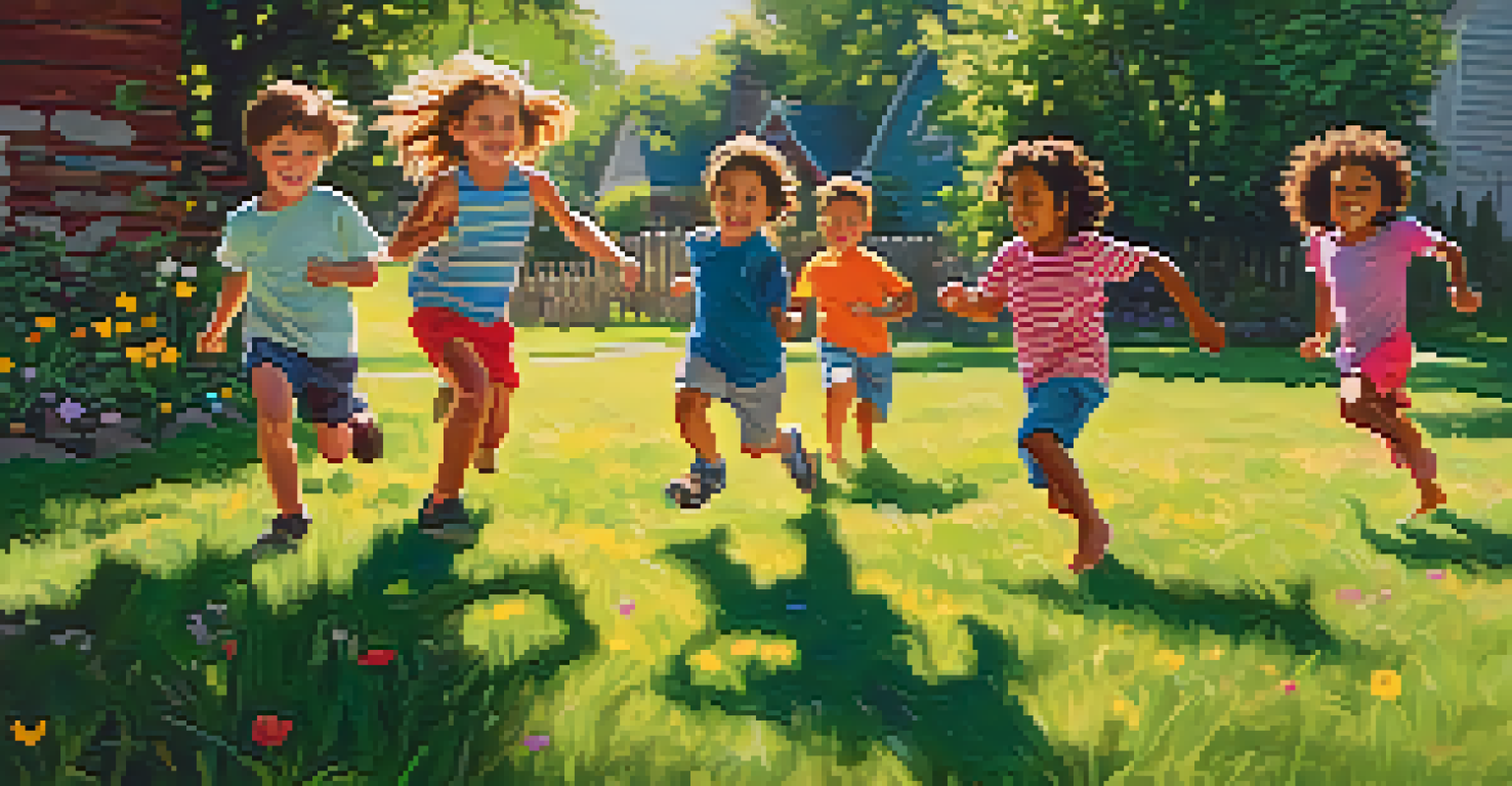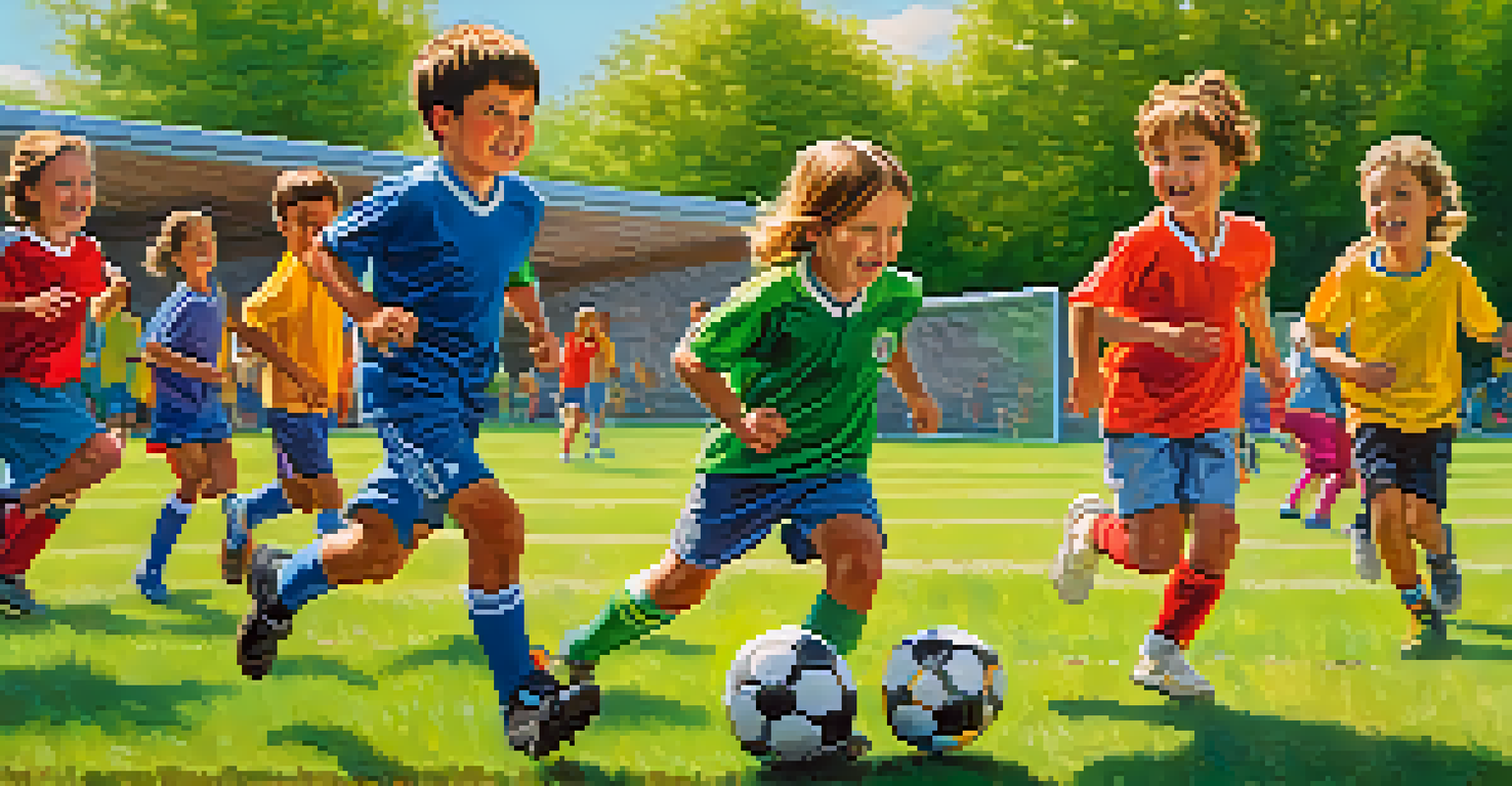Teaching Kids About the Benefits of Physical Activity

Understanding the Importance of Physical Activity
Physical activity is crucial for kids as it lays the foundation for a healthy lifestyle. Engaging in regular exercise helps children develop strong muscles and bones, improves cardiovascular fitness, and enhances coordination. Just like a tree needs strong roots to grow tall, kids need physical activity to thrive.
Physical activity is vital for children as it helps them develop a healthy body and mind.
Moreover, being active reduces the risk of obesity, diabetes, and other health issues later in life. When kids play outside or participate in sports, they're not just having fun; they're also investing in their future health. It's a simple, yet powerful, way to promote well-being.
Additionally, physical activity encourages kids to explore their limits, fostering resilience and determination. These qualities are important not just in sports but in academics and personal challenges as well. By understanding the importance of being active, kids can develop a lifelong appreciation for health.
Making Physical Activity Fun and Engaging
One of the best ways to teach kids about physical activity is to make it fun. Whether it’s playing tag in the backyard, riding bikes, or joining a local sports team, the focus should be on enjoyment rather than competition. When kids have fun, they’re more likely to stick with it.

Try to introduce games that incorporate movement, like obstacle courses or scavenger hunts. These activities not only promote physical fitness but also spark creativity and teamwork. Remember, the goal is to create positive associations with being active.
Physical Activity Builds Health
Regular exercise helps children develop strong muscles, improve cardiovascular fitness, and reduce health risks.
Incorporating technology can also be beneficial; think about interactive fitness apps or video games that encourage movement. By blending traditional play with modern tools, you can capture kids' attention and motivate them to stay active while having a blast.
Setting a Positive Example as a Parent
Kids often mirror the behaviors they see at home, so setting a positive example is vital. If parents prioritize physical activity, children are more likely to adopt similar habits. Think of it as planting seeds; the more you nurture a love for movement, the more it will flourish.
The greatest gift you can give your children is your time, and that includes being active together.
Involve your children in family activities that require movement, such as hiking, dancing, or playing sports together. These shared experiences not only promote health but also strengthen family bonds. Plus, it’s an opportunity to show them that being active can be a source of joy.
Discuss the benefits of physical activity openly with your kids, sharing your own experiences and how it makes you feel. When they see you enjoying exercise, it reinforces the idea that being active is not just a chore, but a rewarding part of life.
Encouraging Team Sports and Group Activities
Team sports provide a fantastic platform for kids to engage in physical activity while learning valuable life skills. Whether it's soccer, basketball, or swimming, participating in sports teaches teamwork, discipline, and a sense of community. These experiences can become some of the most cherished memories of childhood.
Moreover, being part of a team can boost children's confidence and self-esteem. They learn to rely on others and understand the importance of cooperation, which extends beyond the field. It’s an enriching experience that encourages social interaction and communication.
Make Movement Fun for Kids
Incorporating enjoyable activities and games encourages kids to stay active and develop a positive attitude towards fitness.
Additionally, group activities foster a sense of belonging, making exercise a more enjoyable experience. Kids are more likely to stick with physical activity when they have friends to share it with, creating a positive cycle of encouragement and support.
Integrating Physical Activity into Daily Routines
Finding ways to integrate physical activity into daily routines can make it easier for kids to stay active. Simple changes, like walking or biking to school, taking the stairs instead of the elevator, or even having a dance party at home, can add up. Think of these little acts as building blocks for a healthier lifestyle.
Encourage your kids to participate in household chores that require movement, such as gardening, cleaning, or playing outside with pets. Not only do these activities keep them active, but they also teach responsibility and the importance of contributing to the household.
By making physical activity a regular part of your family's routine, it becomes a natural and enjoyable aspect of everyday life. Kids will learn to associate being active with fun, rather than seeing it as another task on a to-do list.
Educating Kids on Health and Fitness
Teaching kids about the benefits of physical activity is as crucial as encouraging them to participate. Start by explaining how exercise affects their bodies and minds, from building stronger muscles to improving mood. A simple analogy, like comparing exercise to charging a battery, can help them understand its importance.
Use age-appropriate resources, like books or videos, that explain health and fitness in a fun and engaging way. Encourage discussions about nutrition, hydration, and the role of exercise in overall well-being. By fostering a curious mindset, kids will be more likely to want to learn and engage.
Set a Positive Example
Parents who prioritize physical activity inspire their children to adopt similar healthy habits through shared experiences.
Make it a family affair by exploring health topics together. Involving kids in meal planning or cooking can also introduce them to the idea that nutrition plays a vital role in their physical activity. This holistic approach makes the connection between being active and being healthy clearer and more impactful.
Celebrating Achievements and Progress
Celebrating achievements, big or small, can significantly motivate kids to stay active. Whether they learn a new skill in sports or simply enjoy a day of play, recognizing these moments fosters a positive attitude towards physical activity. It’s like putting a gold star on their progress chart.
Consider creating a reward system that encourages milestones, such as trying a new sport or completing a fitness challenge. This not only builds excitement but also reinforces the idea that being active is a journey filled with accomplishments.

Moreover, sharing these successes with family and friends can help kids feel proud and supported. When they see that their efforts are valued, it encourages them to continue pursuing an active lifestyle, making physical activity a source of joy and pride.